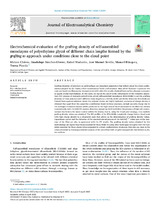Electrochemical evaluation of the grafting density of self-assembled monolayers of polyethylene glycol of different chain lengths formed by the grafting to approach under conditions close to the cloud point
Author
Chávez, Miriam
Sánchez-Obrero, Guadalupe
Madueño, Rafael
Sevilla, José Manuel
Blázquez, Manuel
Pineda, Teresa
Publisher
ElsevierDate
2022Subject
Poly-ethylene glycolSelf-assembled monolayer
Grafting density
Cloud point
Reductive desorption
METS:
Mostrar el registro METSPREMIS:
Mostrar el registro PREMISMetadata
Show full item recordAbstract
Grafting densities of polymers on gold surfaces are important parameters that inform about the chain conformation adopted by the chains, either mushroom or brush conformation. Most of the literature reports on this topic are based on ellipsometry measurements with other few results obtained from surface plasmon resonance or quartz crystal microbalance. In this work, we report the use of cyclic voltammetry of the reductive desorption (RD) process of mercapto-polyethylene glycol self-assembled monolayers (EGn-SAMs) to get the grafting densities of these polymers with different chain lengths (c.a. EG136, EG45 and EG18). When the EGn-SAMs are formed from aqueous solutions where the polymer chains are highly hydrated, an excess of charge density is obtained that apart from the capacitive contribution found in these processes, include an extra charge due to the hydrogen evolution reaction (HER) produced by the high ratio of water contained in the film that reduces concomitantly with the SAM RD process. However, preparing the EGn-SAM in the presence of high salt concentrations that lowers the water content within the chains, that is, using the cloud point strategy, very realistic grafting density values are obtained. The RD profiles of the EGn-SAMs completely change from a broad peak with high charge density to a structured peak that allows us the determination of grafting density values. Capacitance curves and the behavior of the electrochemical process of the Fe(CN)63-/4- redox pair in the presence of the films are also in agreement with the CV results. The grafting density values obtained by this methodology are higher than those reported for these SAMs by using other techniques but agree with the footprints expected for these chains when organized in a brush conformation. Moreover, they also are close to the values obtained by thermogravimetric analysis of the same films built on gold nanoparticles that behave as planar surfaces.

